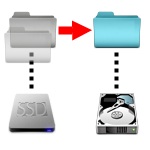 Let’s say you’ve got Windows 7, and you install a second hard drive. Perhaps you have an SSD as your primary drive, and you want to store your GB’s of MP3s, videos, and documents on your second data drive.
Let’s say you’ve got Windows 7, and you install a second hard drive. Perhaps you have an SSD as your primary drive, and you want to store your GB’s of MP3s, videos, and documents on your second data drive.
Well, you could just copy the data into a new folder the old fashioned way. Doing this tends to break Windows 7’s “libraries” feature, and suddenly you have to tell Windows where to find all your files. That’s kind of annoying.
Fortunately, there is a built-in feature for moving your My Documents, My Music, My Videos, My Pictures, and even your Downloads folder automagically – and Windows will still keep track of everything for you!
Here’s how you do it:
- Open Explorer (Win-E if you like keyboard shortcuts)
- Find your way to
C:\Users\[YOUR ACCOUNT NAME] - Right click on the folder you want to move (such as “My Music”) and choose
Properties - Select the
Locationtab - Click the
Movebutton - Select a new location for your goodies. You can put the folder anywhere, and even create new folders and subfolders on any drive to store your loot
- Click
Yeswhen prompted about whether or not you want to actually move all the files over to the new location
That’s it! You can repeat the process for the rest of your “My” folders. Windows apps like Media Player will still know where to find your music and other files.
So, that’s great. But what if, say, you have a custom folder with a bunch of huge files on your C:, and you want to move those to your secondary drive as well?
Maybe you have a folder C:\Junk, and you’ve stored a bunch of files that some of your applications now expect to live in C:\Junk – but you’d rather have them off your boot drive and store them instead on your secondary drive. If you just move the folder to your second hard drive, all those apps will complain.
Enter mklink.
mklink is a seriously handy command line utility in Windows 7 and Vista that let’s you make your own fancy “virtual folders”, otherwise known as “symbolic links” and “hard links” in Linux Land.
To move a folder C:\Junk onto E:\Junk and have your apps still believe that the actual contents in Junk still reside at C:\Junk, do this:
- Move your Junk folder onto E: the old fashioned way
- Click Start and type
cmd(but don’t press enter) - Right click on
cmd.exein the Start Menu and chooseRun as administrator - In the command prompt window, type:
mklink /h /j c:\Junk e:\Junk
(For details of what the command is doing, just type help mklink in a command prompt window.)
Voila! Now you have a C:\Junk and an E:\Junk. The only difference is that your files actually live in E:\Junk, but C:\Junk is hardlinked to E:\Junk. So, if an application tries to access C:\Junk, it is fooled into reading the contents of E:\Junk, even though it still calls the directory “C:\Junk”.
Handy, yes?




Recent Comments